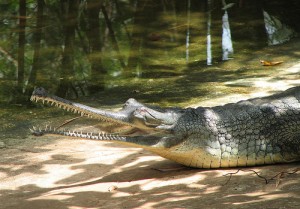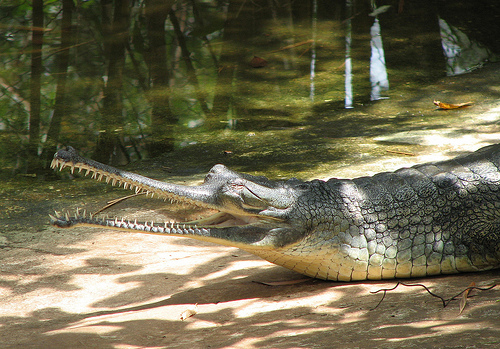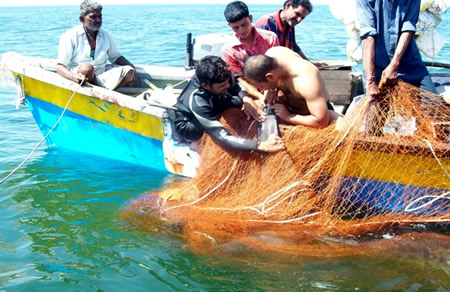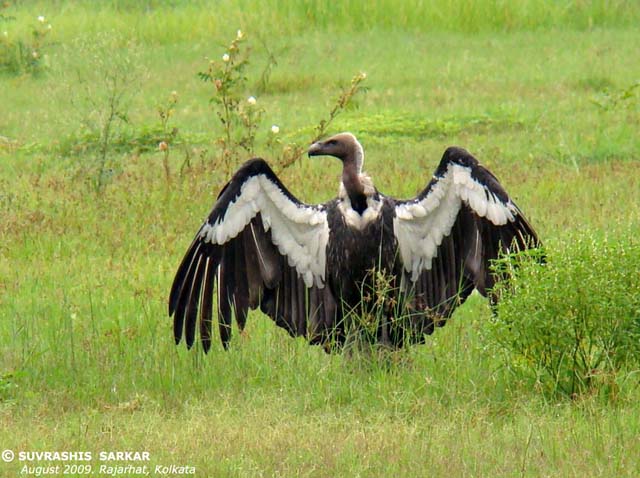 The Indian Gharial is one of the most endangered Crocodile species of the world. Interestingly, the population is fighting a battle of survival not because of difficulty in breeding but because the rivers where these animals live are soon turning into sewers rather than the clean and fresh water habitat that the creatures prefer.
The Indian Gharial is one of the most endangered Crocodile species of the world. Interestingly, the population is fighting a battle of survival not because of difficulty in breeding but because the rivers where these animals live are soon turning into sewers rather than the clean and fresh water habitat that the creatures prefer.
According to Romulus Whitaker, the most prominent herpetologist known in India, the Indian gharial (Gavialis gangeticus ) was once found in India, Nepal, Pakistan, Bangladesh and Bhutan. But now there are only two nations that have a surviving gharial population – India and Nepal with the later having a mere 100 wild gharial population in the Narayani river.
In India, there are currently 2000 wild gharials spread in the freshwater river systems of Ganga, Yamuna, and Chambal. But less than 200 of these are breeding individuals, elevating the risk this species has of getting extinct.
The International Union of Conservation of Nature (IUCN) has listed the Indian Gharial as Critically Endangered making it the most threatened species among large animals in the Indian subcontinent.
No Place to Call Home
According to Whitaker, a wild egg collection, hatching, rearing and release programme was initiated in 1975 by Food and Agriculture Organization consultant Robert Bustard in collaboration with the forest departments of Odisha, Uttar Pradesh, Rajasthan and Madhya Pradesh.
This programmer turned out to be a great success with over 5000 juvenille gharials released into the wild since then. But today, these animals breed in the wild in only three locations namely,
- Corbett National Park
- Katarniaghat Sanctuary
- National Chambal Sanctuary
Sadly, they are now functionally extinct in Odisha.
Whitaker says there is vast misinterpretation among the general public regarding the statistics of the Gharial population. While the successful rate of hatching and breeding shows that the Gharial is on the fast lane to recovery, it is hardly so in reality. And the main reason is River Pollution.
“You would think that gharial conservation is a success story based on the rearing and release project, but you are wrong. It turns out that this is the easiest part of crocodilian conservation work. The good photo and press opportunities offered by the hatch and release programme and the ‘feel-good’ factor have detracted attention from the real problem: habitat loss,” says Whitaker in his article for tehelka.com.
The concerned conservationist poignantly adds,
“India has an international reputation for having some of the world’s most polluted rivers, glaringly outstanding are our ‘holy’ rivers — the Ganga and Yamuna — which have evolved into flowing toxic waste and sewage canals. And gharials (along with a big array of other spectacular river fauna like the Ganges dolphin, chitra turtle and golden mahseer) have no choice but to live in these septic sewers.”
Facts prove that Whitaker is correct in his assumption.
In 2007-2008, 113 gharials died in the relatively clean Chambal river at a point where the river meets the dirty Yamuna. They died due to an as-yet-unidentified nephro toxin, a poison that destroys the kidneys and Whitaker fears such incidents may occur again and again.
Saving the Gharial
The Gharial Conservation Alliance of the Madras Crocodile Bank is working with the gharial range stat carry out much-needed research and conservation programmes.
But the fact is, it is not the species but its home that needs to be saved first. The river that is the path to salvation is turning into a filth ridden toxic sewer where any life form will dread to exist. Washing clothes, releasing industrial waste into the rivers, performing last rites, even dumping dead bodies carelessly into the pious waters, is our way of effortlessly sweeping the dust under the carpet.
The biggest sin is not the ones that people are washing away on the Ganga shores, but the one they are committing right when they take a dip into the river. Ganga, Yamuna and other rivers are first and foremost a freshwater home to many aquatic forms like the Gharial and the Ganga river dolphin. If the river’s living species die, the death of all those creatures is a result of our accumulated sins.
More Related Stories,
57 Animal Species Critically Endangered in India
Western Ghat Aquatic Species Plunging Towards Extinction
Freshwater crocodiles Back from the Brink of Extinction
Image via CC/Flickr by wildxplorer









3 thoughts on “The Dying Gharials”